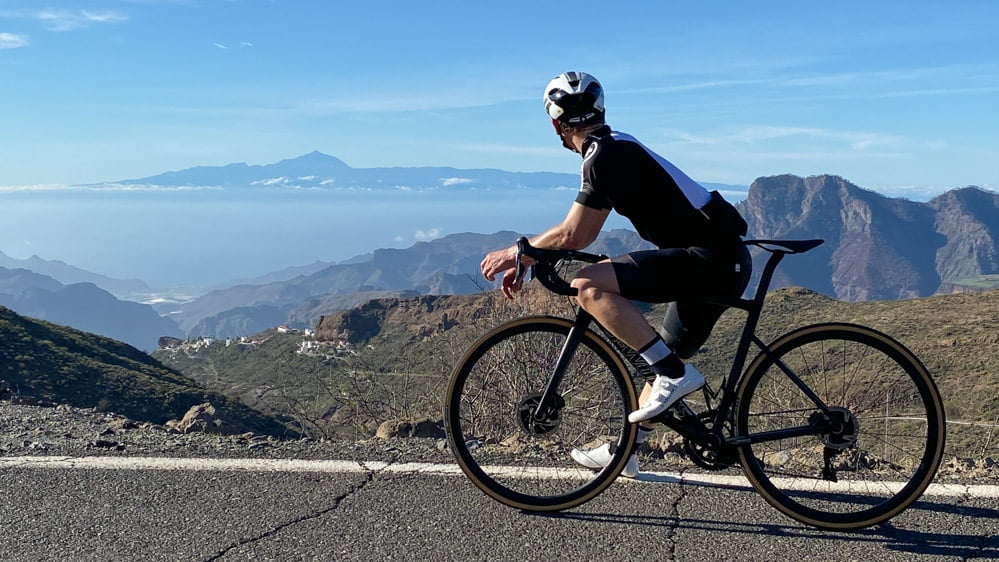If you’re looking for winter sun and varied terrain, a Gran Canaria cycling holiday is definitely one to consider.
The best cycling routes of Gran Canaria’s are possibly less well-known than those of Tenerife and Lanzarote, its neighbouring Canary Island competitors, but we think that makes it an even better choice. You’ll encounter less big groups of cyclists on the road and, in our experience, less vehicle traffic too.
Read on to plan your Gran Canaria cycling holiday
In this article you’ll find loads of information to help you plan your next Gran Canaria cycling holiday: from our favourite Gran Canaria bike routes to bike hotels on Gran Canaria, bike rental in Maspalomas (and other towns) plus when to visit and how to get here.
Listen to a podcast version?
We generated this podcast-style audio from the article below using AI. Let us know what you think!
Why cyclists should consider cycling Gran Canaria
Like the other Canary Islands, Gran Canaria’s climate is reliably beautiful year round (it’s not known as the island of the “Eternal Spring” for nothing). It’s a popular winter season destination for cycling brands to head to for photo shoots, and that speaks volumes. After all, they can’t risk lost days of shooting due to inclement weather.
Gran Canaria’s cycling routes are many and varied. Without a doubt, the island’s Valley of the Tears wins the “most famous Gran Canaria cycling climb” category, but there are many close contenders for “most beautiful” because the landscapes are nothing short of spectacular. When considering Gran Canaria cycle routes, think arid desert cliffs and large pine forests. Indeed since 2005, about half of the island has been part of UNESCO’s list of World Biosphere Reserves.
The island’s urban/town planning may leave a little to be desired and it is perhaps not a top pick for those after luxury cycling hotels, but if you can put up with a bit of 70s brutalist concrete on the coast, then Gran Canaria road cycling can be awesome.
Gran Canaria cycling routes
Overview of Gran Canaria’s roads/geography (from a cyclist’s perspective)
Like many of the Canary Islands, Gran Canaria is dominated by a dormant volcano in the centre of the island; in this case Pico de Las Nieves.
To the north of Pico lies the island’s capital: Las Palmas de Gran Canaria (the big city on the north east coast). When you look at a map, you’ll soon spot that going inland from here there’s a lot of roads, many developments and not much in the way of green.
No surprise then that cyclists heading to Gran Canaria tend to head south of Pico. This is made particularly easy because there are regular international flights into Las Palmas Gran Canaria airport (including Easyjet and Wizz Air). From the airport, you can then easily access the southern resorts and beaches such as Playa del Inglés and Puerto de Mogán, plus of course the epic cycle routes of Gran Canaria.
Which climbs/routes to ride?
The routes you ride while on Gran Canaria will, of course, depend on where you stay (more on that below).
We stayed in Maspalomas, hence the bike routes of Gran Canaria found in this guide are predominantly focused on making Maspalomas your base. It’s worth noting that the main climbs start from different places along the south coast. If very long loops aren’t for you or you’re looking for easy cycling in Gran Canaria, you’ll need to consider either hiring a car and driving to the start of some of the rides, or arranging a transfer.
We’ll start by sharing an overview of the island’s must-do cycling climbs. We then cover the Gran Canaria road bike routes you need to know, followed by some general tips for cycling Gran Canaria.
Gran Canaria cycling climbs
Here’s our pick of the top eight cycling climbs on Gran Canaria. As you can see, there’s everything from shot, sharp ramps to punchy climbs and some seriously challenging climbs too. Something for everyone!
To help with orientation, we’ve ordered these biking Gran Canaria climbs from the most westerly starting point to the most easterly:
Valley of the Tears (GC606)
This is known to many as the hardest climb in Europe, and it’s not hard to see why. The climb from the roundabout in La Aldea de San Nicholas (known as “San Nicholas”) to the junction above Ayacata is a true beast and one of the major challenges when it comes to Canary Islands cycling. It’s 25 kilometres of ascent and the second 11 kilometres are really brutal, with ramps nearing 17%. To conquer this giant, you need not only legs of steel but confidence. If you haven’t got a support car, bear in mind that you’re a long way from home. It really does feel very “end of the world” once you’ve left San Nicolas behind.
Our Valley of the Tears route below includes this climb. If you’re not quite ready for the Valley of the Tears itself but want to ride the stunning roads around it, check out this route.
 Looking down from El Toscón
Looking down from El Toscón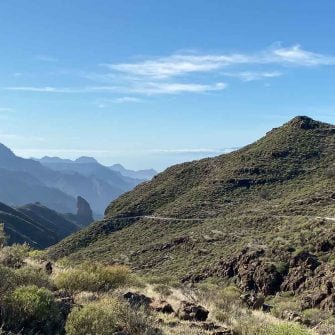 Towards the top of this gruelling climb
Towards the top of this gruelling climb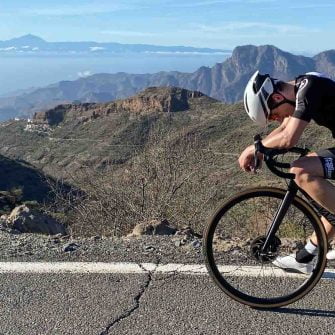 Views towards Mt Teide from the top of the Valley of the Tears
Views towards Mt Teide from the top of the Valley of the TearsSerenity Climb – AKA the TauroPass (GC605)
As the Serenity Climb of Gran Canaria name suggests, the climb up the GC605 after Mogán to the junction in Ayacata, is a beauty. Some people say it’s their favourite of all Gran Canaria biking routes. The road bends and curves over a great road surface, with fantastic views over the coastline and mountain vistas to admire. On paper it doesn’t look too difficult, but the ever changing gradient makes it harder than it looks. The temptation to stop for photos is another potential impediment to your rhythm!
Our Pico de las Nieves route below includes part of this climb.
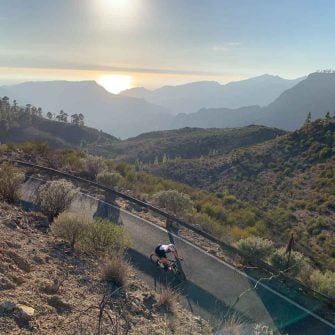 The incredible natural beauty of the GC605
The incredible natural beauty of the GC605 Switchback heaven on the Serenity climb
Switchback heaven on the Serenity climb Passing the Presa de las Niñas reservoir
Passing the Presa de las Niñas reservoirSoria Climb (GC505)
A wonderful, long, consistent, not too hard climb on a road bike in Gran Canaria on the GC505. This takes you from Arguineguín to a nice little restaurant in Soria with fantastic orange juice and a great view. From there you can head back to the fork and (if you’re in the mood for disobedience) take the road marked “no bicycles” to the point where the GC505 meets the GC605 (Serenity climb) on its way up to Ayacata.
Our Pico de las Nieves route below includes this climb.
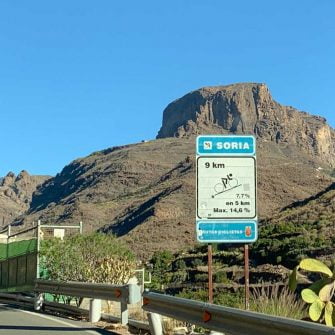 Soria climb stats
Soria climb stats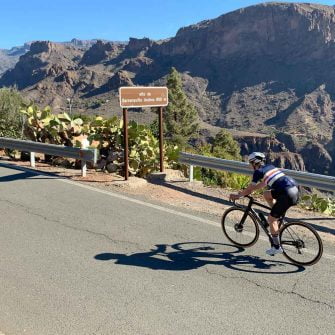 Alto de Barranquilla Andres on the GC505
Alto de Barranquilla Andres on the GC505 Some punishing gradients!
Some punishing gradients!Ayagaures (GC504)
For shorter cycle routes in the Maspalomas area, we really enjoyed the relatively short loop to Ayagaures, a village at the head of a valley. The GC504 makes a convenient loop and is great for a quick blast around the hills, getting away from the urban areas of Maspalomas quickly and out into the desert mountainscapes.
Our Ayagaures loop route below includes this climb.
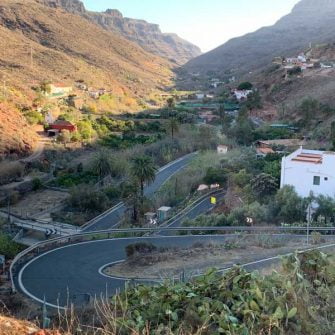 Switchbacks up to Ayagaures
Switchbacks up to Ayagaures Climbing above Ayagaures on the GC503
Climbing above Ayagaures on the GC503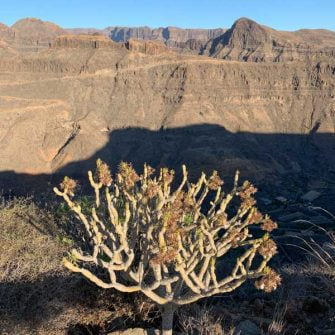 Looking over the Ayagaures valley
Looking over the Ayagaures valleyPico de Las Nieves (via GC60/Fataga)
This is perhaps the classic climb on the island and another reason why Gran Canaria could be the best Canary Island for cycling. It takes you from sea level on the coast, all the way up the GC60 and to the top of the Pico De Las Nieves volcano. It’s a major 3 hour+ effort, but you get a huge sense of achievement over this 48km climb (roughly 1,900m of vertical gain!). It’s not lung-busting effort all the way as there are plenty of short descents on the way up, but keep something in the tank for the last 11 km. This is when the climb kicks again and the gradient becomes a lot steeper. At the top you’ll be at the Roque Nublo, aka the ‘rock in the clouds’. It’s known as a sacred monument on the island and, as you stand contemplating the incredible precipitous views, you can see why.
Our GC60 and GC65 route below includes part of this climb. To do the rest, just carry on up the GC60 after San Bartolomé.
Fataga Climb (on GC60)
The short 4 kilometre section of the GC60 is a segment we particularly like within the ride up to Pico de Las Nieves and it’s a classic of Maspalomas cycling. It comprises a twisting series of switchbacks that comes as you leave Fataga, after a long gradual climb up from the coast. You can see it snaking up above your head, so it feels much worse than it really is! The view from the San Bart View Point at the top is out of this world and not too much further on lies San Bartolomé de Tirajana, a great spot for a stop.
Our GC60 and GC65 route below includes this climb.
 Climbing the GC60 from Maspalomas
Climbing the GC60 from Maspalomas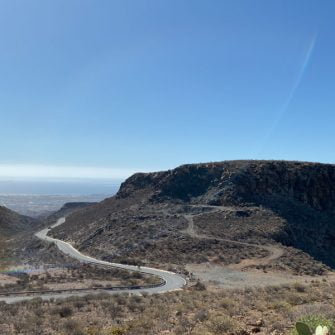 Spectacular surrounds of the GC60
Spectacular surrounds of the GC60 Switchback after Mirador Degollada de la Yegua
Switchback after Mirador Degollada de la Yegua
Pico De Las Nieves (via GC65/Santa Lucia)
An alternative to the classic GC60 and other reason to go cycling in the Canary Islands is this, the climb up the GC65 towards the centre of the island. You pass through the village of Santa Lucia de Tirajana, to meet the GC60 in San Bartolome. From there you can either head back to the coast or continue up to Ayacata and perhaps attempt the final kilometres to Pico de Las Nieves.
You’ll do part of this climb if you reverse our GC60 and GC65 route below.
Pico De Las Nieves (via GC130/Ingenio)
We only descended this route, but it’s got a fearsome reputation as a climb for you and your bike in Gran Canaria. The landscape is wide open with views across the coastline, and you’ll be unlikely to come across any other cyclists.
 Wild open landscapes on the GC551
Wild open landscapes on the GC551 Heading onto the GC550
Heading onto the GC550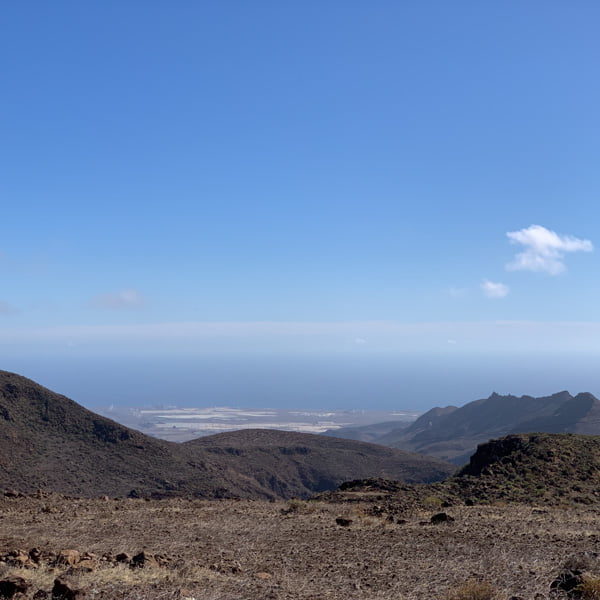 Views looking east over Gran Canaria
Views looking east over Gran Canaria
Cycling routes on Gran Canaria
Below we share our favourite road cycling routes on Gran Canaria. They take in the climbs mentioned above and many more besides. Enjoy!
Below you’ll find links to our articles on the rides above. Click the button to read each article – and enjoy!
Rides
Other cycling routes on Gran Canaria
While there are only five full route guides above, be aware that you can easily use these as a starting point to mix and match your routes depending on where you’re staying and how far you want to go.
By way of example:
- Want to ride the full coast to summit of Pico de las Nieves? Reverse our Pico de las Nieves route and you’ll have a GPS that allows you to climb from Maspalomas to Pico de las Nieves on the GC60
- Want to ride back to Maspalomas from Valley of the Tears? Get a lift to the start in Mogán but ride back to Maspalomas via the GC60.
- Want to do the full Serenity climb from Mogán? Ride our GC500 coast road ride, get the ferry from Puerto Rico to Puerto de Mogán, ride the GC200 Serenity climb to Ayacata then come back to Maspalomas on the GC60.
- For a short ride from Maspalomas, consider riding an out and back on the GC603 or GC604.
Easy Gran Canaria cycling routes
First thing to say is that we wouldn’t suggest beginner cyclists come to Gran Canaria – see our comments below.
If you’re looking for an easier cycling route for a warm-up ride or a rest day ride, two good options would be:
1. The GC503 and 504 Ayagueres loop mentioned above.
2. The rolling GC500 coast road between Maspalomas and Puerto Rico.
- Check out this GPS file for the route.
- From Maspalomas, you head west towards Puerto de Morgan along the GC500.
- Unfortunately, the GC500 is blocked by a landslide just before Puerto de Morgan. This means you can’t ride the whole way along the cost to Puerto de Morgan, and as you also can’t cycle on the motorway (the GC1) you’re limited to an out and back ride.
- That said, if you’ve got a bit of time and don’t fancy anything too tough, this is a good choice.
- You’re looking at about 300m climbing each way and some great coastal views.
- Coffee in Puerto Rico and return?
 On the GC500 rollercoaster heading west from Maspalomas
On the GC500 rollercoaster heading west from Maspalomas Gran Canaria’s coastal resorts are all quite built up
Gran Canaria’s coastal resorts are all quite built up Incongruous sight of Arguineguin concrete works!
Incongruous sight of Arguineguin concrete works!Rules of the road
Be aware of the Spanish Highway Code and also know that outside of the towns, it’s mandatory to wear a helmet.
You may see signs referring to the need to where reflective vests – we understand these signs are informational only, but if you ride in the dark, lighting is mandatory at the front and back of your bike. If your lights don’t work for some reason, then you must wear a reflective safety vest or reflective clothing (for example a jersey with reflective strips).
Road closures
When we were in Gran Canaria, the GC500 between Puerto de Mogán and Puerto Rico was closed (and had been since September 2017). At the time of updating this article, that was still the case. This is a particular problem if you’re staying in Puerto de Mogán because you’re not allowed to ride bikes on the GC1 motorway. This means you either have to get a car transfer if you want to go east or use the ferry… It does have quite an impact on cycling options so please check the latest situation before you travel. (Note: please drop us a line if do you spot that this has changed!)
The other road closure that impacted our route planning was the closure of the GC200 east of Las Marcuegas. The GC200 in Gran Canaria was closed following a rock fall.
Gran Canaria road conditions
Many of the roads we experienced were superb – smooth, rolling tarmac that was beautiful to ride. However, there were also some notable exceptions (Valley of the Tears for example!) – but those exceptions can even be within one road. The general theme is that lower down the road surfaces are better than higher up. For example, on the descent from Pico de las Nieves towards Ingenio, the road surface was terrible up to around Cazadores, but then fine. Likewise, the GC-65 up to Santa Lucia was smooth, but not so good afterwards. It’s something to bear in mind before taking your expensive bicycle to Gran Canaria.
When you’re route planning, bear in mind which roads you’re planning to use. We found the coast road (the GC500) generally very busy and unpleasant to ride. We also found the main roads into the centre of the island (the GC60 from Maspalomas, the GC65 from Vecindario and the GC200 from Puerto de Mogan) busier than other roads going inland, but fine.
Is Gran Canaria suitable for beginners?
Road cycling Gran Canaria is not for beginner riders; while there are a good variety of climbs and not all of them are super steep, flat roads that are nice to ride are scarce.
You’ll note the “that are nice to ride” reference there; that’s because the coast road that you see is flattish, but most of it doesn’t fit the “nice to ride” requirement (the section we identify above in the “easy routes” section is an exception). As you’d guess, the coast road takes the vast majority of the island’s traffic and (especially going east from Maspalomas) there’s a lot of ugly urban development along it. It’s therefore not the most photogenic of routes in Gran Canaria.
How fit do I need to be to for cycling Gran Canaria?
While we wouldn’t recommend Gran Canaria for beginners, you don’t need supreme fitness to enjoy cycling in Gran Canaria. Fortunately, there are sufficient routes to let you pick and choose depending on how fit you are and your objectives for your time on the island. If your focus is more holiday than training camp, just avoid the real monster climbs and go for the shorter loops.
Odds are that by the end of a week in Gran Canaria you’ll be significantly fitter than when you started!
The main thing is that you’re happy with the idea of taking on some hills, climbing and mountain descending as, as we mention above, this is not the destination for quiet flat routes.
Do you need to book a bike tour for Gran Canaria?
If you’re a strong cyclist, experienced at riding in mountains, are with friends and feel confident you’d know what to do in the event of an accident or mechanical, you may not need support for a cycling trip to Gran Canaria.
However, it’s worth knowing that the regions of Gran Canaria the routes here take you through are pretty sparsely populated, especially when you’re away from the coast or the hub of roads that meet near the top of Pico de las Nieves. Unlike the Alps, there aren’t lots of mountain villages with small shops, restaurants and petrol stations that could help you out if you ran out of water/food.
We think the case for going on an organised training camp or tour with a support car/mechanical assistance, is much stronger in Gran Canaria than many destinations (even for experienced riders).
Certainly worth checking out the options.
Where should I stay in Gran Canaria for cycling?
In short, most of the best riding on the island is in the south. Most of the island’s hotels are on the coast, hence most cyclists end up staying on the south coast, in either Puerto de Mogán or Maspalomas.
Puerto de Mogán
From Puerto de Mogán you’re in prime position to tackle the Valley of the Tears loop (and maybe a couple of other rides too) – however, if you want to get rides like the classic GC60 and Pico de las Nieves climbs in the east, you’re in for some big days or you’ll need a transfer.
Maspalomas
From Maspalomas, you’re on the doorstep of the Soria ride and the various Pico de las Nieves cycle routes. This is also where all of the Free Motion bike tours of Gran Canaria start (more info below) and where there are loads of hotels. Be aware that if you stay here you’ll likely need a transfer to the start of the Valley of the Tears ride (unless you’re super strong and don’t mind the ferry ride between Puerto de Mogán and Puerto Rico (ferry is due to a road closure – more on that above).
The mountains
A third option is to stay in the mountains. This would work if you’re relaxed about things like bars/restaurants when you’re off the bike. If this sounds appealing, spending a night or two somewhere like Cruz de Tejeda would be a great option and would mean you could really vary up the riding.
Our detailed guide on where to stay in Gran Canaria (for cyclists) article has a lot more information on what each town is like and also includes our pick of the best Gran Canaria cycling hotels.
Bike hotels in Gran Canaria
Remember to double-check accommodation bike storage arrangements (and any other services you need) before booking as policies often change.
Gran Canaria is really starting to embrace cycling and many hotels are cycling-friendly.
However their marketing is often not that obviously targeted at cyclists. We spent a lot of time trying to understand the best cycling hotels on Gran Canaria/the best places to stay, so we’ve prepared a separate article on this topic.
We share all the detail of the best towns and hotels for cyclists to stay in within our article on the best places to stay in Gran Canaria for cycling.
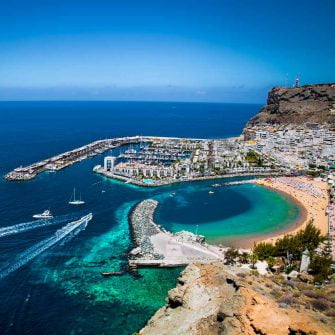 Puerto de Mogán from above
Puerto de Mogán from above View over Maspalomas
View over Maspalomas The inland village of Fataga
The inland village of FatagaBike rental Gran Canaria
Prices, services and bike brands often change. Please let us know if anything is incorrect.
Note that this information changes quickly and, despite our best efforts, it may not have been updated. Please make your own enquiries (and do let us know if you spot any information that needs updating!).
If you’re looking to rent a bike in Gran Canaria, there are plenty of good quality options. However you should reserve before you arrive to ensure you can get the model and size you want, especially during the peak winter season (October to April).
Note that outside of the main winter season, only reduced bike hire in Gran Canarias may be an issue. For example, Free Motion aren’t open on Sundays.
Bike hire options
1. Free Motion (Gran Canaria)
The best known road bike rental in Gran Canaria is offered by Free Motion. They have got shops in various towns (more info below) including Playa del Inglés (where all their cycling tours of Gran Canaria start), Arguineguín, Puerto de Mogán, Meloneras, San Agustín, and Las Palmas. They don’t operate a delivery service, but do have an emergency helpline if you get stuck in the mountains. You can buy insurance against you damaging the bike while using it.
Their bike brands are BH, Cannondales and Specialized. They mostly come with compact 50-34 cranks and either 11-30 or 11-34 cassettes.
You can also sign up for day rides to sample the cycling routes of the Playa del Ingles area. They do offer discounts if you book for three or more.
2. Cycle Gran Canaria
Gran Canaria bike rental is also available via Cycle Gran Canaria. They advertise BH, Haibike, Specialized and Cannondale bikes with mostly compact 50-34 cranks and 11-32 or 11-34 cassettes.
They also offer a 6-day guided and supported Tour of Gran Canaria, as well as a road cycling camp.
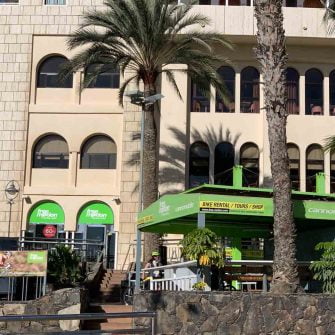
Bike Motion in Maspalomas
3. Other cycle hire in Gran Canaria
Includes:
- Cyclo Canaria (in Maspalomas)
- List n Ride (individuals rent their bikes out)
- Rent Bike Playa Meloneras
Where to find them
Bike rental Maspalomas/Playa del Inglés
Maspalomas and Playa del Inglés pretty much blend into one town, so we’ve included bike hire options for them under one heading.
- Free Motion Bikecenter Playa del Inglés, Hotel Sandy Beach, Av. Alfereces Provisionales s/n, Local 9, 35100 Playa del Inglés. Note: Free Motion’s Maspalomas branch is the HQ for its operations and where all the tours run from.
- Free Motion Bikecenter Meloneras, Shopping Center Oasis Beach, Av. Cristóbal Colón s/n, 35100 Meloneras
- Free Motion Bikecenter Dunas Suites and Villas, Hotel Suites & Villas by Dunas, Avda. Sunair s/n, 5100 Maspalomas
- Rent Bike Playa Meloneras, Local 112 S/N C.C. Playa, 35100 Maspalomas
Bike rental Las Palmas
- Free Motion Bikecenter Las Palmas, Calle Leon y Castillo 323 esq. Calle Italia
- Cycle Gran Canaria, Calle Antonio Lopez San Fernando Las Palmas
Bike rental elsewhere in Gran Canaria
- Free Motion Bikecenter San Agustín, Hotel Gloria Palace, Calle Las Margaritas S/N, 35100 San Bartolomé de Tirajana
- Bike Rental Arguineguin, Free Motion Bikecenter Arguineguín, Viera y Clavijo 1, 35120 Arguineguín (Mogán)
- Free Motion Bikecenter Puerto de Mogán, Hotel Cordial Mogán Playa, Av. De los Marrero, 35138 Puerto de Mogán
When to go to Gran Canaria
The main cycling season is from the start of October until the end of April. These are the months when most of the summer tourists have departed and businesses get really going with their cycling tours and organised trips.
Are there any cycling events in Gran Canaria to aim for?
For event cycling in the Canaries, Gran Canaria Bike Week is an annual event held on and around Pico de las Nieves. It is held in December each year and has been running since 1988.
The Epic Gran Canaria gran fondo happens in early spring each year. If you’re seeking Maspalomas cycling routes, there are two stages that are based around this area.
What’s the weather usually like in Gran Canaria?
The island’s climate is one of the main reasons people plan Gran Canaria cycling holidays.
The north side of the island is known for being windier and rainier than the south side. It seems the mountains in the middle of the island keep the bad weather in the north!
In the south of the island, the weather is generally very good. When you look at the weather forecasts, it can seem like you’re going to be in for some dodgy weather, but it doesn’t usually come to pass. This could be because the forecasts are based on the north of the island. In any event, in the south, between November and March, temperatures are usually between 18 and 25 degrees.
As always, when you climb you can expect temperatures to drop a bit, but it’s not unusual to have temperatures of 16 degrees at the summit of Pico de las Nieves (which is 1,924 meters above sea level!) even in February. For a winter bike tour in Gran Canaria, you should be fine with summer kit and just a pair of arm warmers, and possibly some gloves, for the descents, though you might still want to stick in a rain jacket into your suitcase just in case you get unlucky. There’s not many places you can say that!
 Sunbathing in February at the top of Pico de las Nieves!
Sunbathing in February at the top of Pico de las Nieves! If possible start your rides early to avoid the heat of the day
If possible start your rides early to avoid the heat of the day Gran Canaria offers (pretty much) all year around beach weather!
Gran Canaria offers (pretty much) all year around beach weather!Getting around in Gran Canaria
Having a rental car opens options for family, shopping, dining, rest days, a support vehicle, recceing new routes and non-cycling friends/partners.
Sponsor Message
Use the search box below to search, compare and book the best car rental deal for your trip.
Tips
Travel information
As ever, it’s a good idea to check current travel information before you book and travel. For UK visitors, the UK government travel information pages for Spain are here.
Local water
Consider avoiding Gran Canaria’s tap water. Technically, it’s safe to drink but locals tend to just cook/wash their teeth with it and use bottled water for everything else. The island doesn’t have many natural water sources and much of the water is desalinated sea water, full of chlorine and other minerals, which doesn’t taste great…
Road markings
If you’re driving in Gran Canaria, it’s useful to know that yellow marks on the kerb mean no stopping whatsoever. Blue stripes mean that there’s a charge for parking.
Siesta time
Be aware that many smaller shops close for a siesta, sometimes for as long as 1:30-5pm! However they do then tend to open until at least 8pm at night.
Bikes on buses
If for some reason you need to take your bike on a bus, know that bus drivers are not obliged to allow bikes on buses – it depends on the driver. We’ve heard that usually it’s not a problem but, of course, you might always get a grumpy driver…
Early sunsets
Remember that, despite the daytime temperatures being warm, the sun might not always set as late as you’d expect; in February it set at around 6pm. We were caught out by that a few times!
Tyre width
Tyres. Consider something wider than 25mm tyres – 28s or 32s are likely much more enjoyable as not all the road surfaces on the islands are silky smooth.
Further tips
For more cycling-focused tips for riding in Gran Canaria, read our tips for cycling in Tenerife. They’re focused on Tenerife but there’s lots in there that’s of general relevance.
How to get to Gran Canaria?
Gran Canaria is easily accessible from the UK, with regular flights to Las Palmas airport. Flight time is around 4 to 5 hours depending where you’re coming from.
For visitors outside Europe, the best bet is to fly to Madrid or Barcelona and get a connecting flight.
How big is Gran Canaria?
It may only have a circumference of 235 kilometres, but it’s got a great network of cyclist friendly roads that will easily keep you busy for a week!
How many days do you need in Gran Canaria?
According to Google, most visitors go to Gran Canaria for 12+ days.
However, we’d say a classic length of time for a Gran Canaria cycling holiday would be 7 nights. At around 4-5 hours from the UK, you want to be in Gran Canaria for more than a few days. If you’re happy to base yourself from a couple of different places, there’s certainly enough riding for a longer stay, but all things being equal, you should be able to do the big rides and/or climbs in a week.
Maps and books about Gran Canaria
We bought this Marco Polo Gran Canaria guide before visiting. It’s fine as a general tourist guide, and includes quite a nice map, but obviously it doesn’t contain any cycling specific information.
Sadly, we haven’t come across any cycling specific books about/relating to Gran Canaria. If you have, let us know in the comments below!
A souvenir of Gran Canara
If you’d like something to remind you of your trip to Gran Canaria, how about a GPX based print showing your route in Gran Canaria. Find out more here.
What’s next?
Did you enjoy our guide to Gran Canaria? Let us know in the comments below!
Wondering about the other Canary Islands? Check out our overview of cycling the Canary Islands which is designed to help you pick between the islands. We also have a guide to cycling Lanzarote cycling and Tenerife too.
Like the idea of Gran Canaria for training at altitude? Don’t miss this useful, in-depth guide on altitude training for cyclists.
Other destinations in Spain? Our article on the best places for cycling in Spain is a must-read.
Alternatively, if Spain isn’t for you, check out our destinations page. There you can search by the month you want to travel or cycling destination you want to visit.
Please support Epic Road Rides
A huge amount of time and effort goes into the article you’ve just read, all with the aim of helping you!
If you found what you’ve read useful, I’d really appreciate it if you dropped something in the tip jar here.
It’s a way you can say thank you and help us carry on creating top quality content with no annoying ads and no pay wall.
Looking for an organised cycling trip?
If you want someone to help you plan and book your cycling holiday, fill out this form. We aren’t a tour operator/agent but we work with lots of people who are and will do our best to put you in touch with someone that can help (within 24 hours where possible)!This article includes details of products and/or services that we have used ourselves or which we would consider using. Some are paid features or include affiliate links or referral codes which we may earn commission from. As an Amazon Associate we earn from qualifying purchases. Please read our disclosure policy for further information.
The contents of this website are provided for general information purposes only. It is not intended to amount to advice and you should not rely on it. You should carry out your own due diligence and risk assessments and take professional advice. Views expressed by interviewees or other users of this website do not necessarily represent our views. We make no representations, warranties or guarantees, whether express or implied, that the content on our website is accurate, complete or up to date. If you use any information or content on this website, download from, or otherwise obtain content or services through our website, it is entirely at your own discretion and risk. Epic Road Rides Ltd disclaims all liability and responsibility arising from any reliance placed on the information and content on this website. Find out more here.








